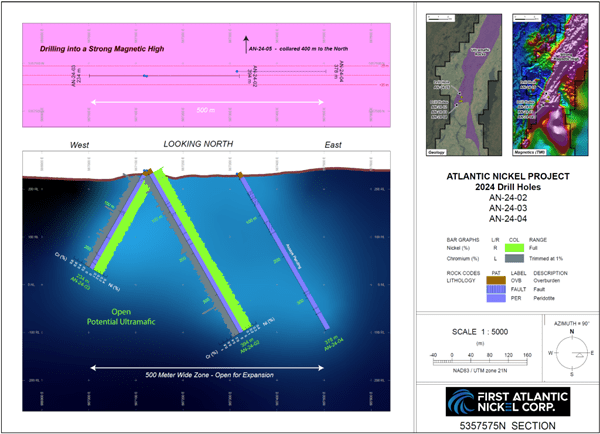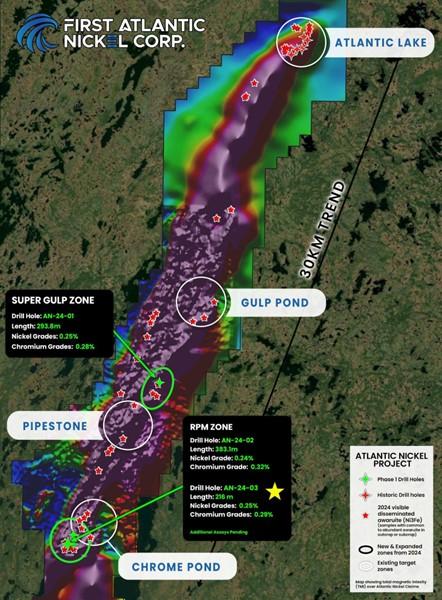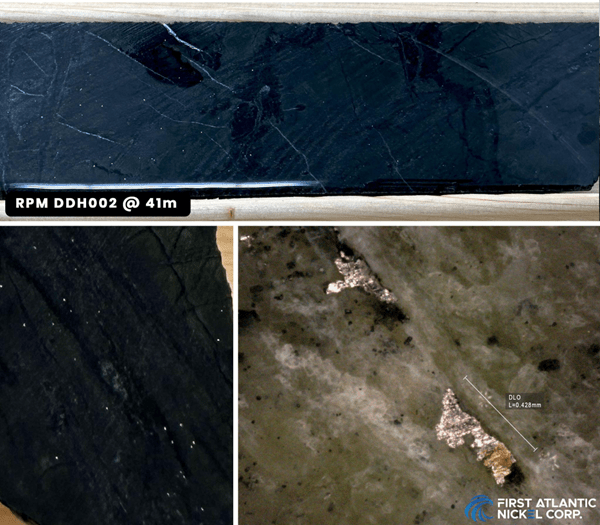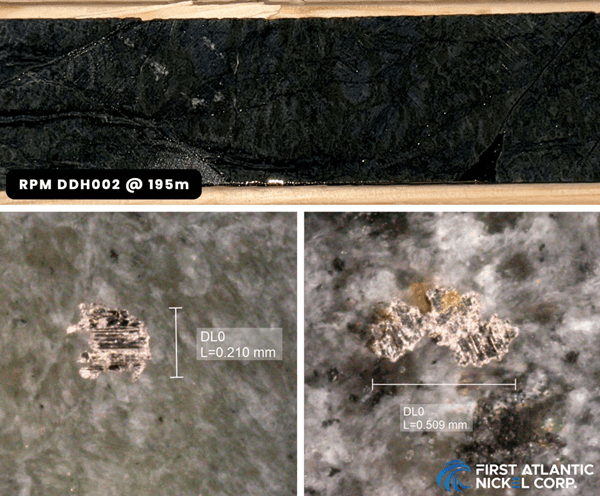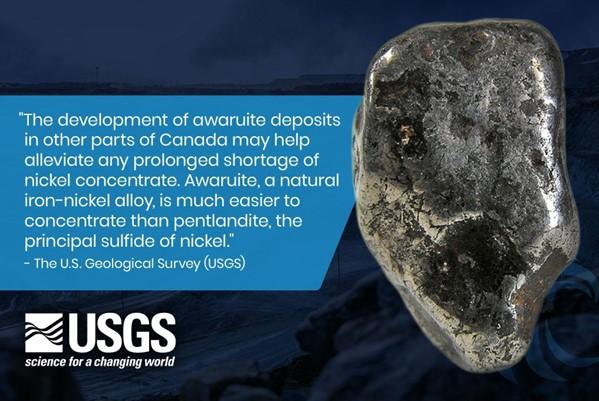
The Prospector News
First Atlantic Nickel Intersects 0.25% Nickel and 0.29% Chromium in Second Discovery Drill Hole at RPM Zone, Confirming Mineralized Width of 300 Meters, with Nickel Grade Increasing to 0.27% in Final 21 Meters Into Fault Zone
You have opened a direct link to the current edition PDF
Open PDF CloseFirst Atlantic Nickel Intersects 0.25% Nickel and 0.29% Chromium in Second Discovery Drill Hole at RPM Zone, Confirming Mineralized Width of 300 Meters, with Nickel Grade Increasing to 0.27% in Final 21 Meters Into Fault Zone
First Atlantic Nickel Corp. (TSX-V: FAN) (OTCQB: FANCF) (FSE: P21) is pleased to announce the assay results from drill hole AN-24-03, the third drill hole of the Phase 1 program and the second drill hole at the RPM Zone, located within its 100%-owned Atlantic Nickel Project in central Newfoundland. The 234-meter hole intersected an average of 0.25% nickel and 0.29% chromium over a continuous 216 meter interval, starting at a depth of 18 meters (post-overburden) and continuing to the end of the hole. Notably, grades increased to 0.27% nickel over the final 21 meters. Drilled westward from the same collar as the initial RPM discovery hole (AN-24-02) which was drilled to the east (see Figure 1), AN-24-03 terminated in a heavily sheared and faulted zone of serpentinized peridotite. The Phase 1 drill rig did not have sufficient power to penetrate this fault zone. Given the increasing nickel grades observed towards the bottom of the hole, Phase 2 drilling will utilize a more powerful drill rig to test further westward into the fault zone and potentially expand the mineralized boundary.
The first four holes of the Phase 1 drilling program at the RPM Zone have outlined a mineralized area measuring 500 meters in lateral width and 400 meters in length, based on visual identification of awaruite nickel mineralization in drill core. Assays from the first two RPM Zone drill holes, AN-24-02 and AN-24-03 (RPM drill holes 1 and 2), have now confirmed 300 meters of the visually identified 500-meter lateral width assaying wide intersections of nickel, with both holes ending in mineralization. These results confirm a robust and laterally extensive mineralized zone with significant potential for expansion in all directions – a target the Company plans to pursue in its upcoming Phase 2 drilling program, which will utilize a more powerful drill rig capable of drilling deeper and longer holes.
HIGHLIGHTS
- Wide Mineralized Intersection: The second RPM discovery hole (AN-24-03) returned an average of 0.25% nickel and 0.29% chromium over a continuous 216 meter drill interval, starting after 18 meters of overburden. Notably, the final 21 meters showed an increase to 0.27% nickel and 0.26% chromium.
- Grades Improving at Depth: The hole ended in mineralization within a heavily sheared and faulted zone of serpentinized peridotite, which the Phase 1 drill rig was not powerful enough to penetrate, suggesting potential for deeper and wider extensions of the mineralized zone.
- Lateral Extent Confirmed: The first four RPM drill holes of Phase 1 delineated a 500 meter by 400 meter area of visual awaruite mineralization, with assays from AN-24-02 and AN-24-03 confirming 300 meters of the 500-meter lateral width, both holes ending in mineralization.
- Visible Awaruite: Coarse-grained, visibly disseminated awaruite, with grain sizes up to 500 microns was observed throughout the 234-meter hole, further supporting the continuity of the mineralization zone.
- Phase 2 Drilling Planned: A more powerful drill rig will be deployed to target the western fault zone and deeper mineralization, aiming to extend the RPM Zone’s boundaries beyond the fault encountered in hole AN-24-03.
- Phase 1 Results: The Company expects to receive additional Phase 1 assay and davis tube recovery (DTR) metallurgical test results in the coming weeks. During Phase 1, processing delays and slower sample submissions resulted from the transition from a temporary, tent-based core processing setup to a long-term core storage and logging facility.
RPM ZONE: DRILL HOLE AN-24-03 OVERVIEW
Drill hole AN-24-03 (also referred to as RPM-DDH002 or RPM Hole 2) was drilled westward from the same collar location as AN-24-02 (RPM-DDH001 or RPM Hole 1), but in the opposite direction, with AN-24-02 drilled to the east (see Figure 1). The objective was to test the western extension of the RPM Zone’s mineralized system. Reaching a total depth of 234 meters, the hole encountered 18 meters of weathered bedrock overburden before intersecting serpentinized peridotite ultramafic rock hosting visible awaruite mineralization. Assays confirmed an average of 0.25% nickel and 0.29% chromium over 216 meters, starting from 18 meters depth. Nickel grades increased to 0.27% over the final 21 meters as the hole entered a heavily faulted zone of serpentinized peridotite ophiolite rocks. The Phase 1 drill rig lacked sufficient power to penetrate the fault, limiting the hole’s depth and resulting in termination within mineralization.
The mineralization, characterized by disseminated awaruite with grain sizes up to 509 microns, was observed throughout the hole, reinforcing the continuity of the mineralized zone. Notable observations include awaruite grains up to 428 microns at a depth of 41 meters (see Figure 3), and grain sizes ranging from 210 to 509 microns at 195 meters (see Figure 4), with coarse awaruite grains present throughout the 216-meter mineralized interval. The increasing nickel grades toward the end of the hole, within the faulted zone, suggest the mineralized system extends westward and at depth, warranting further exploration.
AN-24-03 Drill Hole Table
Table 1: AN-24-03 Drilling Assay results over entire drill hole length.
| Hole ID | from (m) | to (m) | Interval (m) | Nickel (%) | Chromium (%) |
| AN-24-03 | 18 | 234 | 216 | 0.25 | 0.29 |
| including | 18 | 81 | 63 | 0.25 | 0.31 |
| including | 81 | 180 | 99 | 0.25 | 0.30 |
| including | 180 | 213 | 33 | 0.26 | 0.27 |
| including | 213 | 234 | 21 | 0.27 | 0.26 |
| Including “up to” | 0.28 | 0.75 | |||
Table 2: AN-24-03 Drill hole collar location information.
| Hole ID | Easting (UTM NAD83) | Northing (UTM NAD83) | Azm (degrees) | Dip (degrees) | Total depth (m) |
| AN-24-03 | 567118 | 5357574 | 270 | -60 | 234m |
The first four Phase 1 holes at RPM outlined a 500 meter by 400 metre area based on visual awaruite mineralization, with assays from AN-24-02 and AN-24-03 confirming 300 meters of the 500-meter lateral width. Both holes terminated in mineralization, suggesting the RPM Zone remains open for expansion, particularly into the faulted western zone encountered in AN-24-03.
Figure 1: Cross-sectional view of RPM drill holes 1, 2, and 3 (AN-24-02, AN-24-03, and AN-24-04), displaying downhole nickel and chromium assay values. Both reported holes terminate in mineralized rock, indicating potential for further expansion. Assays for the remaining holes are still pending.
Figure 2: A 30-kilometer-long nickel trend map illustrating the locations of Phase 1 drill holes, featuring nickel and chromium assay results for AN-24-01, AN-24-02, and AN-24-03. Notably, AN-24-03 yielded an average of 0.25% nickel and 0.29% chromium across its full 216-meter length.
Figure 3: Core sample from RPM drill hole 2 (AN-24-03) at a depth of 41 meters, showing visible awaruite grains. The lower images display magnified views of these grains under a microscope, with sizes reaching up to 428 microns.
Figure 4: Core sample from drill hole RPM drill hole 2 (AN-24-03) at a depth of 195 meters, featuring visible awaruite mineralization. The lower images show magnified views of the awaruite grains, with sizes ranging from 210 to 509 microns.
PHASE 2 DRILLING OBJECTIVES: ZONE EXPANSION
Building on these promising results and the increasing grades observed near the fault, First Atlantic is preparing for Phase 2 drilling, which will utilize a higher-powered drill rig to:
- Drill deeper to define the vertical extent of the RPM Zone mineralization.
- Expand the lateral width beyond the current 500-meter footprint.
- Extend the strike length beyond the current 400-meter footprint through strategic step out drilling.
- Penetrate the faulted zone encountered in drill hole AN-24-03 to test the western extension of the mineralized system.
Assays and DTR metallurgical test results for the remaining Phase 1 drill holes are still pending, as the transition to a new core storage and processing facility during the program caused delays in processing core and sample submission.
Awaruite (Nickel-iron alloy Ni₂Fe, Ni₃Fe)
Awaruite, a naturally occurring sulfur-free nickel-iron alloy composed of Ni₃Fe or Ni₂Fe with approximately ~75% nickel content, offers a proven and environmentally safe solution to enhance the resilience and security of North America’s domestic critical minerals supply chain. Unlike conventional nickel sources, awaruite can be processed into high-grade concentrates exceeding 60% nickel content through magnetic processing and simple floatation without the need for smelting, roasting, or high-pressure acid leaching1. Beginning in 2025, the US Inflation Reduction Act’s (IRA) $7,500 electric vehicle (EV) tax credit mandates that eligible clean vehicles must not contain any critical minerals processed by foreign entities of concern (FEOC)2. These entities include Russia and China, which currently dominate the global nickel smelting industry. Awaruite’s smelter-free processing approach could potentially help North American electric vehicle manufacturers meet the IRA’s stringent critical mineral requirements and reduce dependence on FEOCs for nickel processing.
The U.S. Geological Survey (USGS) highlighted awaruite’s potential, stating, “The development of awaruite deposits in other parts of Canada may help alleviate any prolonged shortage of nickel concentrate. Awaruite, a natural iron-nickel alloy, is much easier to concentrate than pentlandite, the principal sulfide of nickel”3. Awaruite’s unique properties enable cleaner and safer processing compared to conventional sulfide and laterite nickel sources, which often involve smelting, roasting, or high-pressure acid leaching that can release toxic sulfur dioxide, generate hazardous waste, and lead to acid mine drainage. Awaruite’s simpler processing, facilitated by its amenability to magnetic processing and lack of sulfur, eliminates these harmful methods, reducing greenhouse gas emissions and risks associated with toxic chemical release, addressing concerns about the large carbon footprint and toxic emissions linked to nickel refining.
Figure 5: Quote from USGS on Awaruite Deposits in Canada
The development of awaruite resources is crucial, given China’s control in the global nickel market. Chinese companies refine and smelt 68% to 80% of the world’s nickel4 and control an estimated 84% of Indonesia’s nickel output, the largest worldwide supply5. Awaruite is a cleaner source of nickel that reduces dependence on foreign processing controlled by China, leading to a more secure and reliable supply for North America’s stainless steel and electric vehicle industries.
Disclosure
Adrian Smith, P.Geo., is a qualified person as defined by NI 43-101. The qualified person is a member in good standing of the Professional Engineers and Geoscientists Newfoundland and Labrador (PEGNL) and is a registered professional geoscientist (P.Geo.). Mr. Smith has reviewed and approved the technical information disclosed herein.
Analytical Method & QAQC
Samples were split in half on site with one half remaining in the core box for future reference and one half packaged in secure bags. QAQC method included the use of blanks, duplicates and certified reference material (standards) with one being inserted once in every 20 samples in order to test the precision and accuracy of the lab. All results passed the QA/QC screening at the lab, and all company inserted standards and blanks returned results that were within acceptable limits.
Samples were sent to Activation Laboratories LTD in Fredericton, NB. Actlabs is an ISO 17025 certified lab, accredited and acting independently from First Atlantic Nickel. Each sample was crushed, with a 250 g sub-sample pulverized to 95% – 200 mesh. A portion of the sample is fused with a lithium metaborate/tetraborate flux and analyzed by ICP-OES for major oxides and elements including cobalt, chromium and nickel.
True widths are currently unknown. However the nickel bearing ultramafic ophiolite and peridotite rocks being targeted and sampled in the Phase 1 drilling program at the Atlantic Nickel Project are mapped as several hundred meters to over 1 kilometer wide and approximately 30 kilometers long.
About First Atlantic Nickel Corp.
First Atlantic Nickel Corp. is a Canadian mineral exploration company developing the 100%-owned Atlantic Nickel Project, a large-scale nickel project strategically located near existing infrastructure in Newfoundland, Canada. The Project’s nickel occurs as awaruite, a natural nickel-iron alloy containing approximately 75% nickel with no-sulfur and no-sulfides. Awaruite’s properties allow for smelter-free magnetic separation and concentration, which could strengthen North America’s critical minerals supply chain by reducing foreign dependence on nickel smelting. This aligns with new US Electric Vehicle US IRA requirements, which stipulate that beginning in 2025, an eligible clean vehicle may not contain any critical minerals processed by a FEOC (Foreign Entities Of Concern)6.
First Atlantic aims to be a key input of a secure and reliable North American critical minerals supply chain for the stainless steel and electric vehicle industries in the USA and Canada. The company is positioned to meet the growing demand for responsibly sourced nickel that complies with the critical mineral requirements for eligible clean vehicles under the US IRA. With its commitment to responsible practices and experienced team, First Atlantic is poised to contribute significantly to the nickel industry’s future, supporting the transition to a cleaner energy landscape. This mission gained importance when the US added nickel to its critical minerals list in 2022, recognizing it as a non-fuel mineral essential to economic and national security with a supply chain vulnerable to disruption.
MORE or "UNCATEGORIZED"
Doubleview Extends High-Grade Domains at Hat: H099 Returns 438m of 0.40% CuEq Including 52m of 1.02% CuEq, Expanding Mineralization Envelope Around Conceptual Pit Vertically and Laterally
Doubleview Gold Corp. (TSX-V: DBG) (OTCQB: DBLVF) (FSE: 1D4) is pleased to announce assay results f... READ MORE
Cosa Closes Upsized C$7.5 Million Private Placement
Cosa Resources Corp. (TSX-V: COSA) (OTCQB: COSAF) (FSE: SSKU) is pleased to announce that it ... READ MORE
Americas Gold and Silver Closes US$132.25 Million Bought Deal Financing
Americas Gold and Silver Corporation (TSX: USA) (NYSE American: USAS) is pleased to report that it h... READ MORE
1911 Gold Closes C$23 Million "Best Efforts" Life Offering & Private Placement and Provides Corporate Updates
1911 Gold Corporation (TSX-V: AUMB) (FRA: 2KY) is pleased to announce that it has completed its prev... READ MORE
Endeavour Silver Completes US$350 Million Offering of Convertible Senior Notes
Endeavour Silver Corp. (NYSE: EXK) (TSX: EDR) announced today the closing of its previously announce... READ MORE













